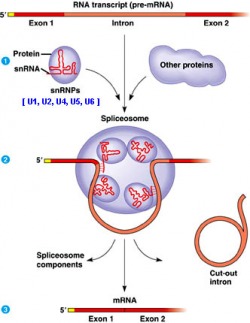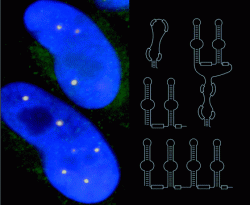This web page was produced as an assignment for Genetics 677, an undergraduate course at UW-Madison
Gene Ontology
Using AmiGO I was able to find 7 gene ontology terms that related to the SMN1 gene in homo sapiens.
1. GO:0000387 : spliceosomal snRNP biogenesis
Biological Process
2. GO:0000245 : spliceosome assembly Biological Process
3. GO:0015030 : Cajal body Cellular Component
4. GO:0005737 : cytoplasm Cellular Component
5. GO:0005829 : cytosol Cellular Component
6. GO:0005654 : nucleoplasm Cellular Component
7. GO:0005515 : protein binding Molecular Function
Considering the SMN1 interacts with snRNP and forms complexes with other splicesomal proteins, it makes sense that we would find these processes in the gene ontology. SMN1 is also localized next to Gemini of Cajal Bodies(term 3). SMN1 acts in subnuclear and other ctyoplasmic areas, thus explaining legitimizing terms 4-6. Term 7 is related to the first 2 terms, but it is a description of the molecular function that the SMN1 protein plays when interacting with the other proteins that help aid its defintion.
1. GO:0000387 : spliceosomal snRNP biogenesis
Biological Process
2. GO:0000245 : spliceosome assembly Biological Process
3. GO:0015030 : Cajal body Cellular Component
4. GO:0005737 : cytoplasm Cellular Component
5. GO:0005829 : cytosol Cellular Component
6. GO:0005654 : nucleoplasm Cellular Component
7. GO:0005515 : protein binding Molecular Function
Considering the SMN1 interacts with snRNP and forms complexes with other splicesomal proteins, it makes sense that we would find these processes in the gene ontology. SMN1 is also localized next to Gemini of Cajal Bodies(term 3). SMN1 acts in subnuclear and other ctyoplasmic areas, thus explaining legitimizing terms 4-6. Term 7 is related to the first 2 terms, but it is a description of the molecular function that the SMN1 protein plays when interacting with the other proteins that help aid its defintion.
Using GOALL I was able to find 12 GO Terms(protein binding was in duplicate) that related to the SMN1 gene in homo sapiens.
Terms in addition to those found by AmiGO:
1. mRNA processing biological process
2. RNA splicing biological process
3. nucleus cellular component
4. spliceosome cellular component
5. RNA binding molecular function
Most of these terms are similar to the some of the ones previously found by AmiGO, thus adding little new information. However, accurate knowledge of the specific functions of the gene will be useful in the overall scheme of gene ontology project.
Terms in addition to those found by AmiGO:
1. mRNA processing biological process
2. RNA splicing biological process
3. nucleus cellular component
4. spliceosome cellular component
5. RNA binding molecular function
Most of these terms are similar to the some of the ones previously found by AmiGO, thus adding little new information. However, accurate knowledge of the specific functions of the gene will be useful in the overall scheme of gene ontology project.
Analysis
It was very simple to find results and navigate for more information using AmiGO. Explanations of all the GO terms is easily linked to and additional information can quickly be found and accessed. The same can be said of GOALL. However they did not list the GO number. This site did give more information although it may not be as orgnaized as AmiGO.
Information on spliceosomal formation and cajal bodies can be found below
Information on spliceosomal formation and cajal bodies can be found below
Spliceosome Formation

(Figure 1)
SMN-1 is related to snRNP biogenesis which is the formation and assembly from one or more snRNA and multiple protein components of a ribonucleoprotein complex that in involved in formation of the spliceosome. These snRNPs assemble to form the spliceosome which is crucial in preparing DNA for transcription.(2) If there is an error in SMN-1 and it cannot function with these proteins, spliceosome assembly will fail and products of the cell will go untranscribed.
SMN-1 is related to snRNP biogenesis which is the formation and assembly from one or more snRNA and multiple protein components of a ribonucleoprotein complex that in involved in formation of the spliceosome. These snRNPs assemble to form the spliceosome which is crucial in preparing DNA for transcription.(2) If there is an error in SMN-1 and it cannot function with these proteins, spliceosome assembly will fail and products of the cell will go untranscribed.
Cajal Bodies

(Figure 2)
Cajal Body - A class of nuclear body, first seen after silver staining by Cajal in 1903, enriched in small nuclear ribonucleoproteins, and certain general RNA polymerase II transcription factors; ultrastructurally, they appear as a tangle of coiled, electron-dense threads roughly 0.5 micrometers in diameter; involved in aspects of snRNP biogenesis; the protein coilin serves as a marker for Cajal bodies. Some argue that Cajal bodies are the sites for preassembly of transcriptosomes, unitary particles involved in transcription and processing of RNA.(1)
Cajal Body - A class of nuclear body, first seen after silver staining by Cajal in 1903, enriched in small nuclear ribonucleoproteins, and certain general RNA polymerase II transcription factors; ultrastructurally, they appear as a tangle of coiled, electron-dense threads roughly 0.5 micrometers in diameter; involved in aspects of snRNP biogenesis; the protein coilin serves as a marker for Cajal bodies. Some argue that Cajal bodies are the sites for preassembly of transcriptosomes, unitary particles involved in transcription and processing of RNA.(1)
References:
1. AmiGO (2009) Cajal Body. retrieved Mar 28, 2009 from: http://amigo.geneontology.org/cgi-bin/amigo/term-details.cgi?term=GO:0015030&session_id=9511amigo1238301548&+
2. AmiGO (2009) Spliceosomal snRNP biogenesis. retrieved Mar 28, 2009 from: http://amigo.geneontology.org/cgi-bin/amigo/term-details.cgi?term=GO:0015030&session_id=9511amigo1238301548&
3. Figure 1: Molecular Genetics (2008) Overview of Protein Synthesis. retrieved May 13, 2009 from: http://www.bio.miami.edu/~cmallery/150/gene/mol_gen.htm
4. Figure 2:Oxford Journals.(2008) Nucleic Acids Research. retrieved May 13, 2009 from: http://nar.oxfordjournals.org/content/vol30/issue21/cover.dtl
1. AmiGO (2009) Cajal Body. retrieved Mar 28, 2009 from: http://amigo.geneontology.org/cgi-bin/amigo/term-details.cgi?term=GO:0015030&session_id=9511amigo1238301548&+
2. AmiGO (2009) Spliceosomal snRNP biogenesis. retrieved Mar 28, 2009 from: http://amigo.geneontology.org/cgi-bin/amigo/term-details.cgi?term=GO:0015030&session_id=9511amigo1238301548&
3. Figure 1: Molecular Genetics (2008) Overview of Protein Synthesis. retrieved May 13, 2009 from: http://www.bio.miami.edu/~cmallery/150/gene/mol_gen.htm
4. Figure 2:Oxford Journals.(2008) Nucleic Acids Research. retrieved May 13, 2009 from: http://nar.oxfordjournals.org/content/vol30/issue21/cover.dtl
William Baader
[email protected]
May 13 2009
www.gen677.weebly.com
